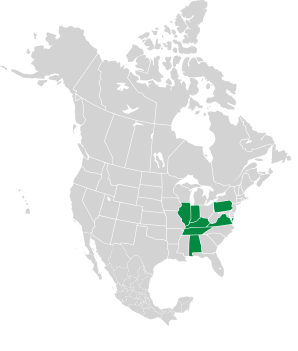Actaea cordifolia auct. non DC.
Cimicifuga cordifolia auct. non (DC.) Torr. & A. Gray
Cimicifuga racemosa (L.) Nutt. var. cordifolia auct. non (DC.) A. Gray
Cimicifuga rubifolia Kearney

|
Actaea rubifolia (Kearney) Kartesz Appalachian bugbane
The “bugbane” in Appalachian bugbane refers to its unpleasant-smelling flowers' ability to repel insects. This is a North American native, and an endangered species. There are small populations in Tennessee, Virginia, Alabama, and the lower Ohio River Valley. |
9/14/2010 · Garden in the Woods, Framingham, Massachusetts · ≈ 7 × 11″ (18 × 27 cm) |
||||||||||||||||||||||||||||
|
Some similar plants: | |||||||||||||||||||||||||||||
Actaea racemosa |
You are here Actaea rubifolia |
Sanicula canadensis |
|||||||||||||||||||||||||||
|---|---|---|---|---|---|---|---|---|---|---|---|---|---|---|---|---|---|---|---|---|---|---|---|---|---|---|---|---|---|
| Common Name |  |
 |
 |
||||||||||||||||||||||||||
| Plant | Plants reach 10-24″ (25-60 cm). | Plants are 12-55″ (30-140 cm) tall. | Plants are 1-2′ (30-60 cm) high. Stems are light green, sometimes furrowed. | ||||||||||||||||||||||||||
| Flowers | White flowers form on tall stalks up to 8′ (2.5 m) in height, with the flowering portions up to 1½′ (50 cm) tall. | White flowers form long, attractive, feathery-looking spikes 6-24″ (15-60 cm) long, straight or slightly curved. Individual flowers have 5 sepals and are about ⅜″ (9.5 mm) in diameter. | Small clusters, greenish-white, not especially interesting. | ||||||||||||||||||||||||||
| Leaves | Leaves often occur in groups of three, on thin stems, and are saw-toothed. | Toothed, shaped like maple leaves. Leaflets are 6-12″ (15-30 cm) long. | In groups of three, and are less than 3″ (7.6 cm) long. | ||||||||||||||||||||||||||
| Fruit | Black or dark brown seeds. | Fruits are ⅛″ (3 mm) around, and reddish brown. | Seed pods are about ½″ (1.3 cm) in diameter, and resemble burrs, with small hooks. | ||||||||||||||||||||||||||
| Range/ Zones |
|
|
|
||||||||||||||||||||||||||
| Habitats | Rich soils in moist woods, ravines | Rich woods, open rocky woods, thickets | |||||||||||||||||||||||||||
| Type | Wild | Wild | Wild | ||||||||||||||||||||||||||
| Occurrence | Common | Endangered | Common | ||||||||||||||||||||||||||
Identification: Plants are 12-55″ (30-140 cm) tall. Leaves are toothed, and shaped like maple leaves. Leaflets are 6-12″ (15-30 cm) long. The white flowers form long, attractive, feathery-looking spikes 6-24″ (15-60 cm) long, straight or slightly curved. Individual flowers have 5 sepals and are about ⅜″ (9.5 mm) in diameter. Fruits are ⅛″ (3 mm) around, and reddish brown.
Edibility: Poisonous ![]() I couldn't find specific information for
this species, but other members of this family are very poisonous.
I couldn't find specific information for
this species, but other members of this family are very poisonous.
Online References:
The Coastal Maine Botanical Gardens
Biodiversity of the Oak Ridge Reservation
9/14/2010 · Garden in the Woods, Framingham, Massachusetts · ≈ 1½ × 1′ (52 × 34 cm) 
Actaea cordifolia auct. non DC.
Cimicifuga cordifolia auct. non (DC.) Torr. & A. Gray
Cimicifuga racemosa (L.) Nutt. var. cordifolia auct. non (DC.) A. Gray
Cimicifuga rubifolia Kearney
Actaea rubifolia description by Thomas H. Kent, last updated 9 Aug 2023.
© FloraFinder.org. All rights reserved.
9/14/2010 · Garden in the Woods, Framingham, Massachusetts · ≈ 7 × 11″ (18 × 27 cm) 
Range:
